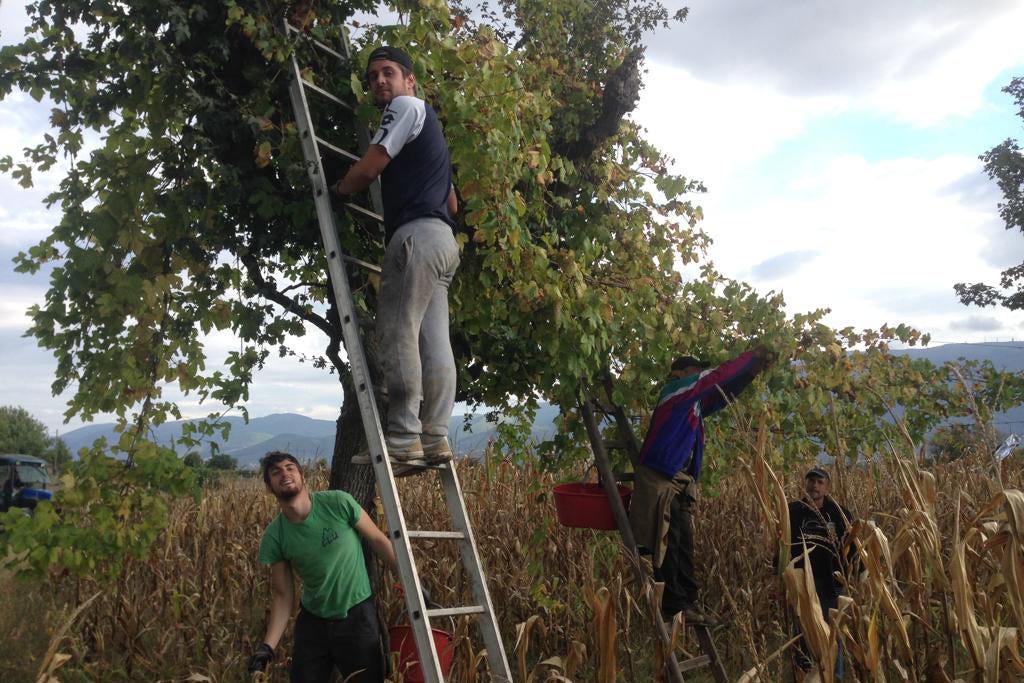Vite Maritata Makes a Comeback
Not all vineyards are designed as tidy rows of short, trellised grapevines. Across Italy, survives a millennia-old vine growing tradition involving tall grapevines. These vines are often centenary and ungrafted—intertwining with trees such as field maples or willows. The vines and trees are in a lifelong companionship that sounds as romantic as it is visually attractive. The trellising practice is called vite maritata, or vine married to a tree.
Here’s a look at where this practice originated, why it fell out of favor and how it’s making a comeback.
Vite Maritata’s Origins
It’s believed the practice was developed and popularized by the Etruscans, a pre-Roman, late-Bronze and Iron Age civilization. The Etruscans planted vite maritata vines across their entire territory, ranging from Lombardy down to western Campania.
“They used it to maximize yields and to gain surface space in between rows to plant other cultures,” explains Nicola Numeroso, owner of I Borboni, a pioneer of modern vite maritata vine growing in Campania, an area located between Naples and Caserta. It was still widely practiced in Campania as late as the 1980s. At the time, the practice was also found in other Italian regions, including Veneto, Emilia Romagna, Tuscany, Marche and Umbria.
But from the late 19th century onwards, particularly following World War II, winegrowing saw increased industrialization that led to the practice gradually disappearing as a regular feature of the Italian landscape. This left only a few, neglected remnants of this millenary history scattered across the country.
Until recently.
The Revival of Vite Maritata

Over the past decade, growers across Italy have begun reviving the practice. Arnaldo Rossi, owner of Taverna Pane e Vino, has worked with 180 centenary vite maritata plants located between the Florence and Siena provinces since 2015 and has become somewhat of an expert in the area.
“Lots of people come to visit me [to learn about vite maritate], from Italy and abroad; Viticulturists, wine professionals and researchers. Somebody from Cognac is experimenting with it,” says Rossi. “We believe this area was packed with vite maritata. Here, trees are planted in rows, 30 feet apart from each other with 100 feet in between rows, intended for wheat or other cereals.”
But why the increased interest? The vite maritata training system was historically designed to maximize production: plants as high as 80 feet could yield hundreds of pounds per cordon.
To ensure he gets higher-quality grapes, Rossi drops the yields by pruning the vines significantly shorter. “Some give me 45 pounds, others give me nothing,” he says. He grows a mix of common local grapes such as Trebbiano, Malvasia, Sangiovese, Canaiolo Nero and lesser-known indigenous strains.
Further South, in Umbria, Giampiero Bea, owner of Paolo Bea winery and founder of Vini Veri, a consortium of wine producers who refrain from using chemicals and additives, is also committed to recover as many of the region’s vite maritata as possible.
“All the ones I can find I take them up for ‘adoption’ from elderly growers who are no longer able to prune them and are willing to hand over the baton to me,” says Bea. Over the years, Bea managed to adopt a dozen different plots, for a total of about 270 married vines.
“Maintaining a good relationship with these old growers isn’t always easy, in fact, it’s quite labor-intensive,” Bea says. “The vines on the other hand, aren’t as demanding as you might expect—once the pruning is done they require little attention.”
Another added benefit to this trellising system is that they grow about 10 feet from the ground where both frost and diseases, such as downy mildew, are unlikely, notes Bea. “So there is very limited need for treatments,” he says.

Further North in the Marche, enologist Andrea Polidoro is in the process of expanding a plot of about 25 Malvasia di Candia vite maritata vines he has recently salvaged.
Polidoro agrees that his ungrafted, centenary vite maritata do indeed offer a naturally sustainable vine growing solution. “I’m amazed by their resilience [to diseases and climate change]… they have a first-rate genetic makeup,” he says.
Polidoro explains that because these vines are heartier, he’s been able to harvest grapes on the same day for the past three years—despite major differences in weather patterns. Whereas it took a bit more planning to find the best harvest date for his nearby grafted vines.
When compared to his conventionally trained Malvasia, the grapes from vite maritata vines accumulate less sugar and develop a higher natural acidity too, both of which come in handy as the climate warms up. This is because hot weather encourages more phenolic ripeness and photosynthesis, which leads to the development of more sugar and less acid. More sugar leads to more alcohol and without the acidity to back it up, you’re left with a flabby wine.
Obstacles for Vite Maritata
Despite the vines withstanding certain environmental changes, others have proved catastrophic.
“We lost two out of six acres of our vite maritata to wind storms,” says Numeroso. “Before climate change, these sorts of tropical storms were unknown here… we also suffer from droughts and the trees need a lot of water.”
On top of unpredictable weather, societal changes mean that recovering lost plants—as well as caring for those that are left—is no easy feat.
“Younger generations don’t want to do these manual jobs anymore, so even here, finding pruners is becoming increasingly difficult,” says Numeroso.
Indeed, while the number of people willing to take on caring for these vines is shrinking, there are still some winemakers willing to champion the practice.
“I thought that only the elderly cared about it, instead there are other younger people like me,” says Numeroso.
Giuseppe Luongo, is a good example of a young winemaker using vite maritata. In 2019, he took over one acre of vite maritata that had catered for his family’s domestic wine needs until the 1980s, when home production ceased. “In the vineyard, I do everything by myself. It’s very labor-intensive, but for me, it’s about valuing a century-old tradition,” he proudly points out.
Finally, the specific equipment required to cater to these plants is in short supply, as pickers need a tailor-made, 50-foot chestnut ladder, which can run upwards of $2,200. These allow for a more efficient grape harvesting process as opposed to standard ladders. In addition to them being costly, the extremely tall chestnut trees required to grow these ladders aren’t as available anymore, Numeroso notes.
Though these vines are slowly making a comeback across Italy, winemakers can only hope that younger generations continue to take on the practice and the technique.




